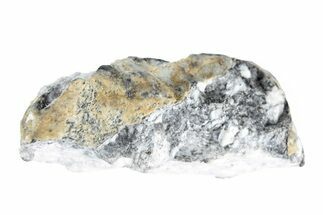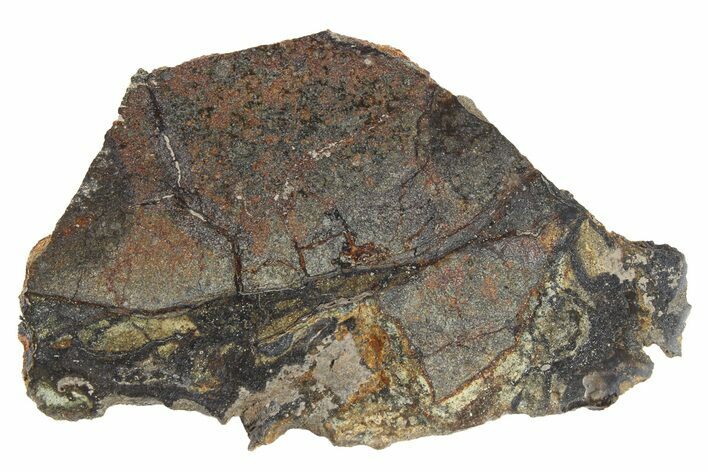This Specimen has been sold.
3.95" Aubrite Meteorite (54.8 g) - Al Haggounia 010
This is a 3.95" wide (54.8 gram) slice of the meteorite known as Al Haggounia, an unusual kind of chondrite called an aubrite, meteorites made of entstatite in igneous and impact-melted clasts. It likely comes from a E-type asteroid. The single 35-kilogram stone was recovered in Western Sahara in 2006.
This slice has been expertly polished on one side to reveal the incredible clasts and shock features contained within this meteorite's interior. It comes with an acrylic display stand.
This slice has been expertly polished on one side to reveal the incredible clasts and shock features contained within this meteorite's interior. It comes with an acrylic display stand.
About Chondrites
Chondrites are stony (non-metallic) meteorites that have not been modified by either melting or differentiation of the parent body. They are formed when various types of dust and small grains in the early Solar System accreted to form primitive asteroids. Some such bodies are captured in the planet’s gravity well and pulled to the surface. They are by far the most common type of meteorite, representing about 86 percent of all meteorites that have fallen to Earth.
Prominent among the components present in chondrites are the enigmatic chondrules, millimeter-sized spherical objects that originated as freely floating, molten or partially molten droplets in space; most chondrules are rich in the silicate minerals olivine and pyroxene. Chondrites also contain particles of various metals such as nickel, iron, and aluminum. These formed at the very beginning of the solar system and aggregated over time: they are the oldest rocks known on Earth!
Chondrites are divided into about fifteen distinct groups on the basis of their mineralogy, bulk chemical composition, and oxygen isotope compositions. The various chondrite groups likely originated on separate asteroids or groups of related asteroids. Each chondrite group has a distinctive mixture of chondrules, refractory inclusions, matrix (dust), characteristic chondrule sizes, and other components. Other ways of classifying chondrites include weathering and shock. The L chondrite group is the most common of these.
Chondrites are stony (non-metallic) meteorites that have not been modified by either melting or differentiation of the parent body. They are formed when various types of dust and small grains in the early Solar System accreted to form primitive asteroids. Some such bodies are captured in the planet’s gravity well and pulled to the surface. They are by far the most common type of meteorite, representing about 86 percent of all meteorites that have fallen to Earth.
Prominent among the components present in chondrites are the enigmatic chondrules, millimeter-sized spherical objects that originated as freely floating, molten or partially molten droplets in space; most chondrules are rich in the silicate minerals olivine and pyroxene. Chondrites also contain particles of various metals such as nickel, iron, and aluminum. These formed at the very beginning of the solar system and aggregated over time: they are the oldest rocks known on Earth!
Chondrites are divided into about fifteen distinct groups on the basis of their mineralogy, bulk chemical composition, and oxygen isotope compositions. The various chondrite groups likely originated on separate asteroids or groups of related asteroids. Each chondrite group has a distinctive mixture of chondrules, refractory inclusions, matrix (dust), characteristic chondrule sizes, and other components. Other ways of classifying chondrites include weathering and shock. The L chondrite group is the most common of these.
TYPE
Aubrite Chondrite
LOCATION
Saguia el Hamra, Western Sahara
SIZE
3.95 x 2.55 x 0.2", 54.8 grams
CATEGORY
SUB CATEGORY
ITEM
#266673
 Reviews
Reviews













